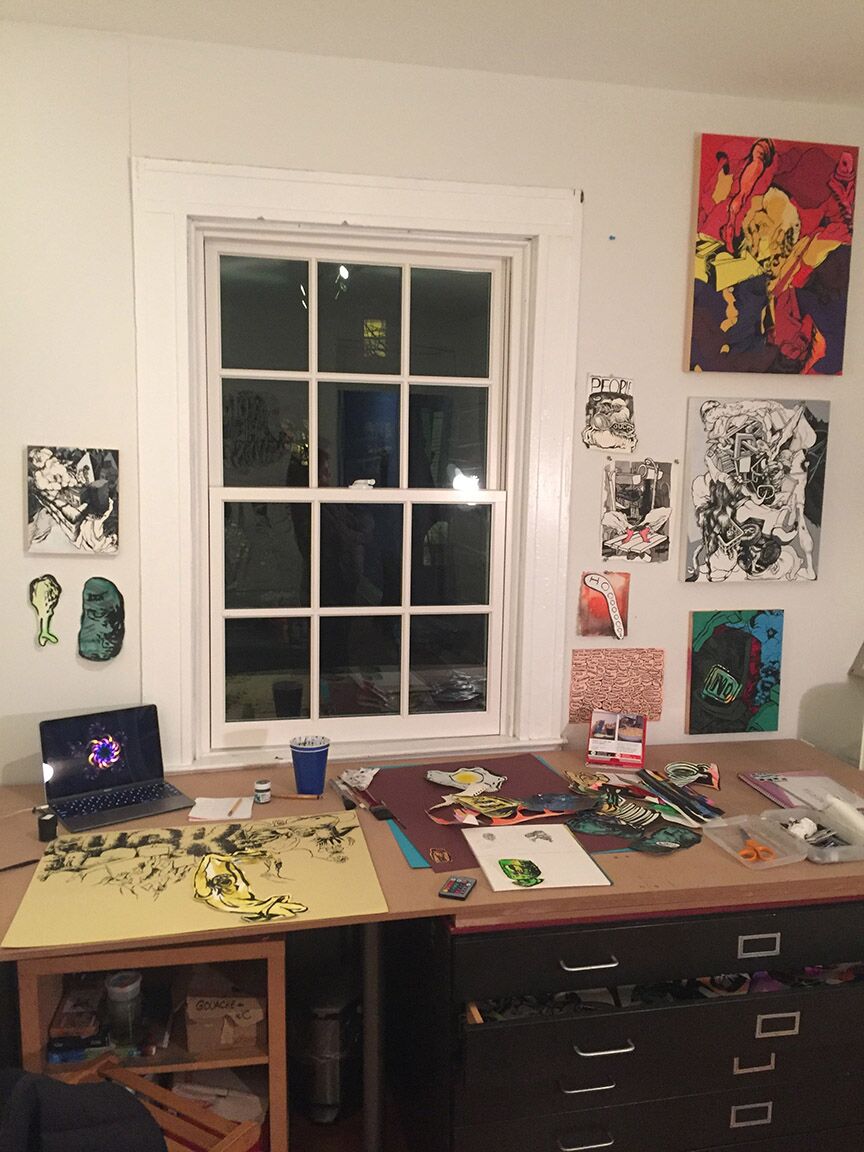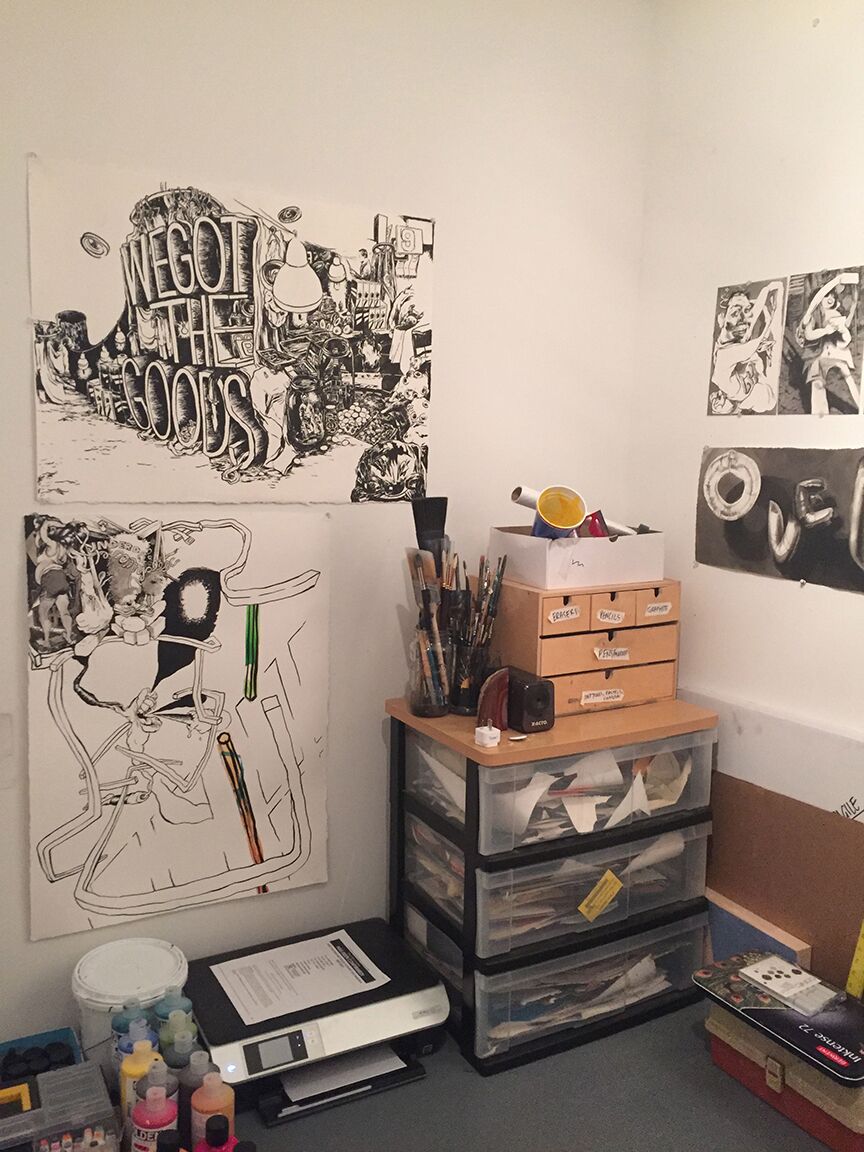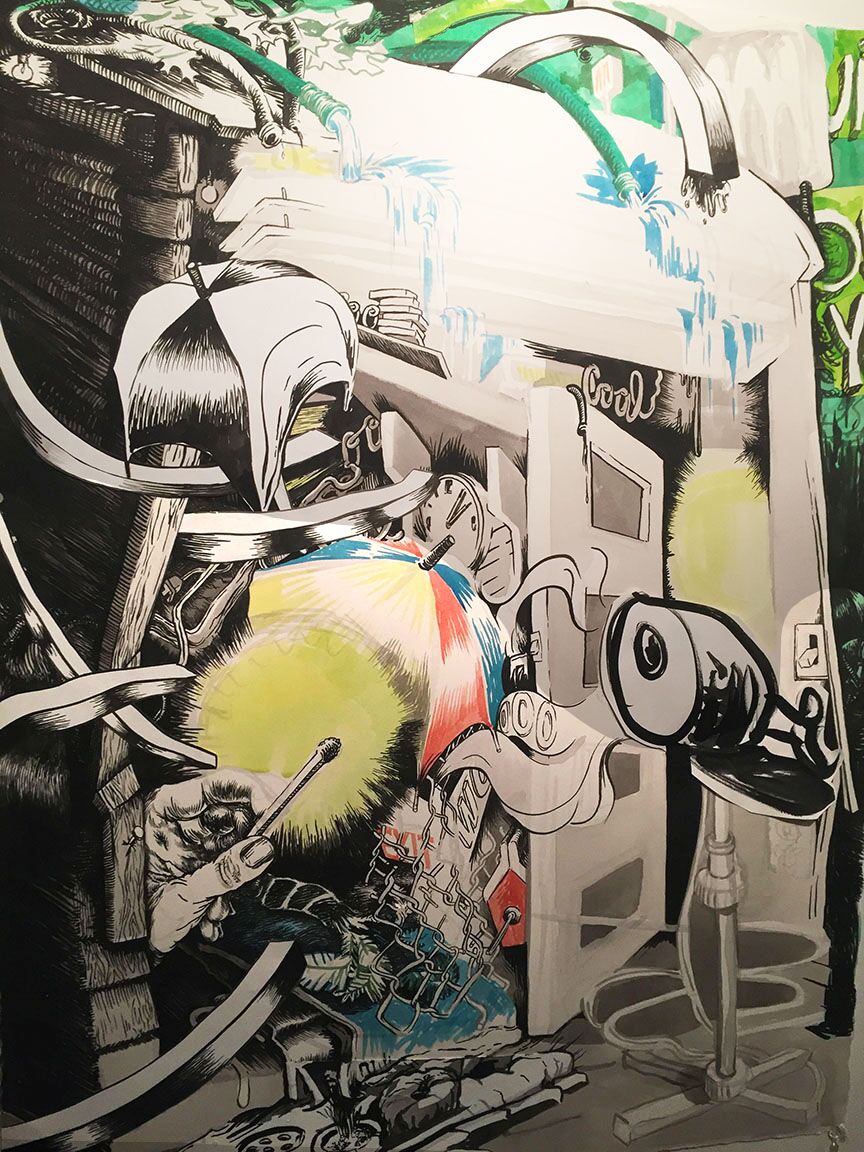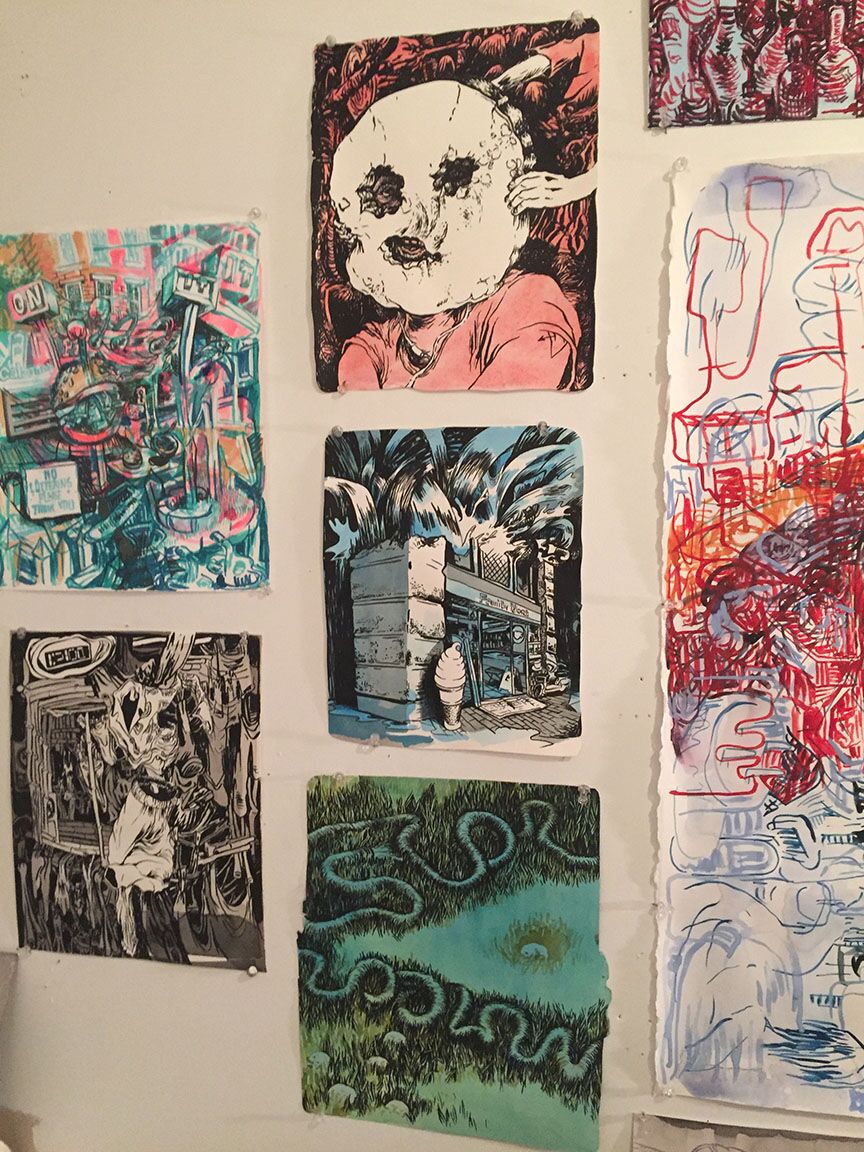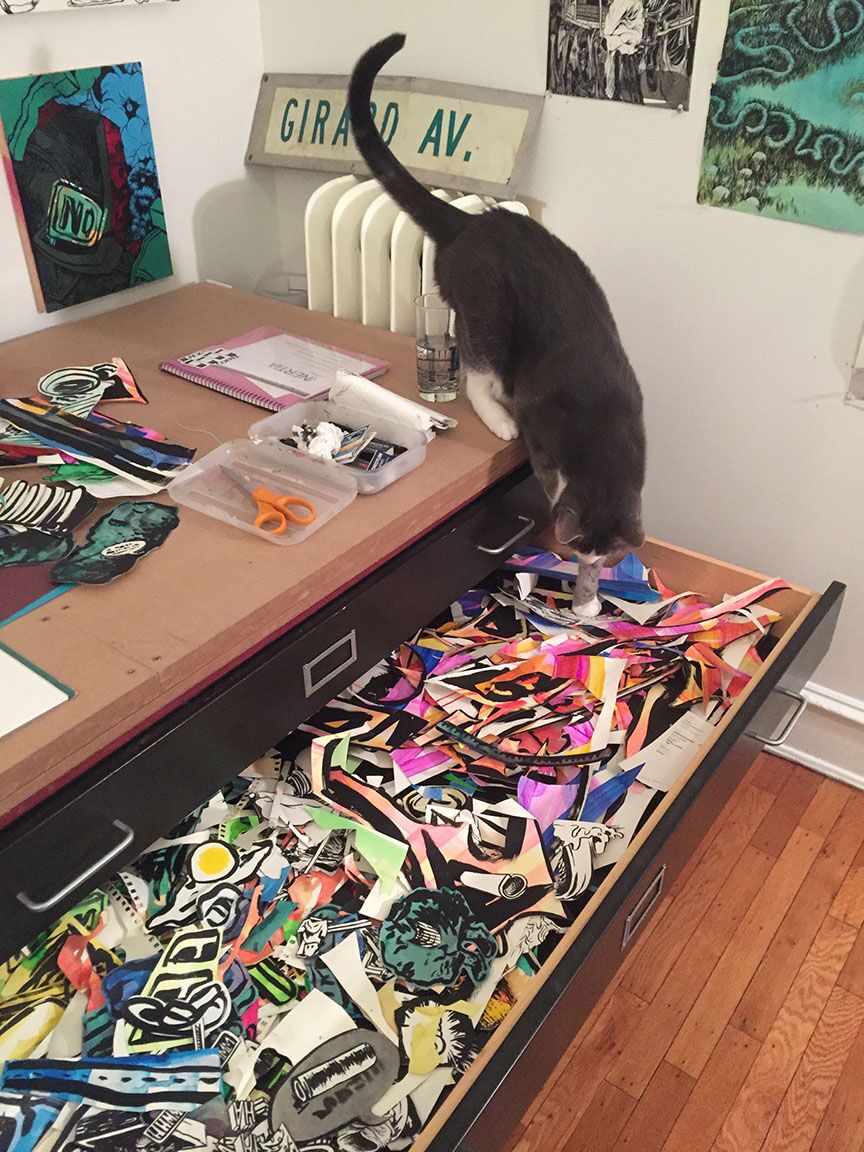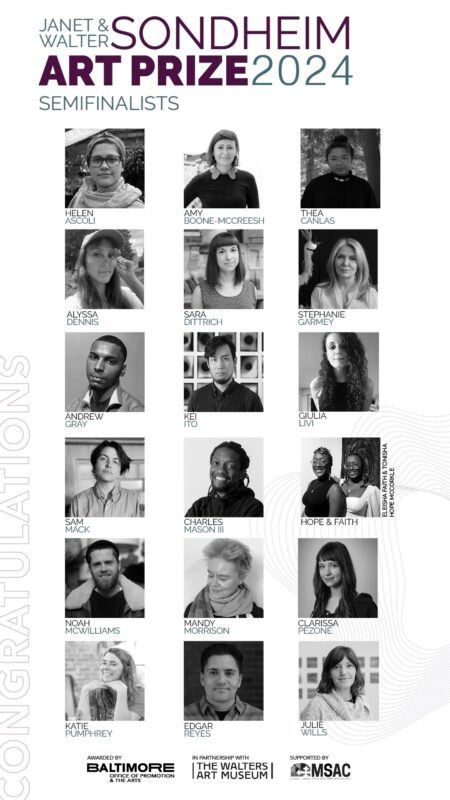Amy Boone-McCreesh Visits the Baltimore Studio of Amanda Burnham
Amanda Burnham considers herself to be a perpetual renderer; these drawings sometimes remain in their original format, but often become large, immersive installations that reference pop culture, architecture, and signage. Most of the work in her studio, and many of her installations, are made with ink and watercolor. Amanda is a graduate of both Yale (MFA) and Harvard (BFA). She is currently Associate Professor and Foundations Coordinator for the Art+Design, Art History, and Art Education department at Towson University. Recently, she completed a collaboration with Laure Drogoul in the bathroom (yes, the bathroom) at School 33 and she has a solo show opening at VisArts in May.
When I started graduate school in 2008 at Towson University, Amanda was new faculty. She had arrived one year prior and graciously guided me and my peers while serving on our graduate committees, amongst her other roles for the department. Amanda invited me to her home studio in early February where we talked about urban environments, sports, and her need for a studio practice that is connected to the outside world.

“RFP” 2015, Paper, paint, cardboard, tape, lumber, lights, variable. Installation view of “RFP” at EMP Collective, Baltimore, MD, January-February 2015
Where did you grow up?
Toledo, Ohio. In terms of art making I would say that growing up there definitely impacts the fact that I look at cities the way that I do. Toledo is quintessentially Midwestern. It’s flat and sprawling, with farmland and strip malls, but also very industrial in places. I read somewhere that Toledo is one of the top test markets nationally for chain restaurants, and as a result has more restaurants per capita than anywhere else in the country. I think I’m very attuned to stuff like the weird, shaped signs at places like chain businesses and strip malls because of seeing all of this as I grew up.
I am also really taken with the opposite- when I moved to the east coast for the first time for school, moving to Boston, I had never been farther east than maybe Pittsburgh. My preexisting idea of the East Coast was informed by how it was depicted in television shows.
When I first saw Boston and New York (and eventually Baltimore) first hand, I was so enamored of all the ways those cities were different from the Midwest – spaces that were dense, dynamic, and mixed use, where a lot of space is shared, and neighbors weren’t a thing you mostly avoided or ignored.
What is the driving force behind your work?
Drawing. I really believe in that sense that drawing, as a process, is an ethic. I have bought into the idea that the importance of making a drawing isn’t so much about what you make, but about how the process allows you to filter the world. It’s about fine-tuning the attention you pay to your surroundings, and further, how you reflect on that, how you understand everything around you. In that way, I find it really useful, and it’s something I wish everyone did all the time. It’s a way of knowing. Even when I draw on a small scale, it ends up becoming a part of my installation work — I draw a lot and notice the images that keep bubbling which in turn become motifs I end up focusing on. Lately word bubbles and limbs have become motifs for me.
What is your biggest struggle in the studio?
Finding balance. I love my job; it’s amazing, and, in a lot of ways, it feeds my studio practice. After graduate critiques I find myself with so many thoughts and ideas— it’s such a rich experience. It feeds into what I do outside of teaching, but it can be exhausting. The temptation to come home and veg is very real.
Just getting started in the studio can be hard. Having a home studio gets obstacles out of the way and makes it a little easier to work. I get really antsy in traditional studio setups — if I feel too locked in, I feel the urgent need to get out. This has a lot to do with the nature of my work though; I always want outside stimulus. I like to hear traffic and people, it helps me to not feel confined, and there is more to respond to. It’s comforting for me to hear noise.
Put the following terms in order of importance to your studio practice: Form, Concept, Process.
I would say that I start with process, because drawing is such a big part of my work. Concept, and then form.
 Detail of C-Span drawings
Detail of C-Span drawings
Was there ever a time when you felt like you couldn’t keep making work? If so, what helped you to keep going?
Definitely, I am very particular with many things in my life. I really have to be in the mood to make work. My life has to be right; there have been times when I just had to adjust to being somewhere. When I first moved to Baltimore, it took me a while to want to do anything. There were too many things in disarray as a result of feeling dislocated.
Work is a great thing to do when things aren’t settled, because it gives me something to focus on, but that is still hard to do. I think everyone has the impression that everyone else has it all figured out, or that you are the only one that doesn’t know what’s going on. The thing I have learned to get through moments of disequilibrium is to just do what you can. Sometimes what you can do is cut paper, or draw while watching TV. Just find a way to make something happen and follow that until things change again. There are times for all different kinds of labor.
Do you have any routines, rituals, or coping mechanisms that you use regularly in your studio practice?
Routines, for sure. If I have a full studio day, which I can usually get twice a week, or more in the summer, I keep to a pretty particular schedule. Set an alarm, wake up, go downstairs, make coffee, feed the cats, turn on the radio. It’s a banal sequence but it really has to happen or my day hasn’t started. I don’t like to just wake up and start working; I end up feeling disconnected. I don’t want to feel too separate from the world. Whether it is a studio day or not, these routines things really set the table for me. It’s not remarkable but it’s essential.
Do you have any hobbies or interests outside of your studio practice that help keep you sane?
I feel like I have too many! This is what makes me feel like a bad artist sometimes. I love to do things outside of studio practice. I like to run, which is such a good way of observing things. Actually, in that way, it is a part of my studio practice. I don’t run with music, I like to hear and see weird things; it’s like being a tourist in your own city.
I love sports; I am a product of my upbringing. I love competitions, I love going to football and baseball games. When the Olympics are on I freak out. I love to read about sports; I have fantasy football teams. I like to travel and read and write. I don’t write for any external purpose but I love doing it, just for myself. My husband and I like games; we have a lot of game nights, and we do bar trivia regularly. (Our team has made it to the citywide championships, though we’ve never won!)

If you had to describe your life to someone out of the Arts, how would you do that?
I would describe it like being a person that has four or five different jobs that are interrelated. You are sort of an independent contractor that does a number of things that all come from a similar place. I do have my full time teaching job, but it mixes with everything else. Every day is different; it depends on the day and time of year, but each week is always some combination of teaching time, studio time, or mental health time. Besides teaching and making, it’s a mix of many different activities — installing, giving talks, reading, interacting with people- these activities happen repeatedly but the mix of these things are never the same day to day.
Do you think the Internet is helping or hurting us as artists and people?
I think it both helps a lot and hurts a lot. Currently I think I come down more on the “it hurts” side, but by a narrow margin. There are many amazing things about it and many horrific things about it — on the whole the shitty things edge the great things. It’s so hard to not be distracted.
I grew up with lots of TVs around, and as result I am weirdly comforted by the constant buzz of TV, but it doesn’t demand as much as the Internet. The Internet always compels you to do something with it; TV doesn’t demand that, it can just be on in the background. I feel strongly that there is a certain subset of people, of which we are both a part, who were significantly impacted by the fact that the internet didn’t start to happen until we were almost adults, but still young enough that we could pick it up and feel native to it. Having both sides of that is a very strange perspective.
If we could go back to a pre-cell phone age I would take that. I think the democratizing aspect of the internet is amazing, and access to information is amazing, and we learn so much, but I just hate that I wake up in the morning and at all times feel like I need to deal with my phone.
I can’t get it out of my head; I am either falling prey to the urge to look at it or I am thinking about how I am tempted but am not looking. It is like being on a diet – there is so much guilt! Maybe it is better for people that have always had the internet, because they don’t feel that guilt. I would probably also give a different answer on a different day but where I am right now is not feeling great about it all.

Is there anything you would like to promote? Upcoming exhibitions, projects, passions?
In May I have a solo show opening VisArts in Rockville. I have been working on some books lately, including Rage Faces which can be found at Printed Matter and locally at Atomic Books. I made the drawings for this book while on a residency in China over the summer. I was really distracted by politics; it’s all drawings of people at Trump rallies.

********
Keep Going: Inertia is a monthly studio visit blog series that aims to make use of a consistent model and series of questions for visual artists. The content of the studio visits will highlight the struggles of a regular studio practice and the drive to keep working. National and International artists are to be featured to examine different approaches to working as a contemporary artist. Inertia will deliver the content through a compact and easily consumable format, allowing visitors to engage regularly and reliably.
Author Amy Boone-McCreesh is a Baltimore-based artist, writer, and professor.
This interview was conducted in Baltimore, MD, in February 2017.
To see more work, head to Amanda Burnham’s website.



